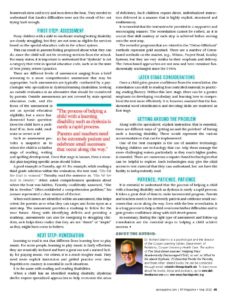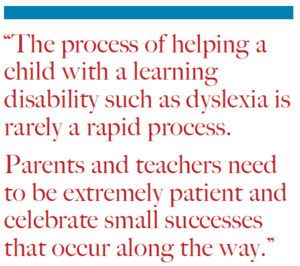Parents frequently consult with me asking whether or not I think their child has dyslexia. When I ask the parents if they know what dyslexia is, a vast majority will say something like: “Isn’t that when you read upside down and backwards?”
This article originally appeared digitally in May, 2022 here. It is reposted by Cooper University Health Care with permission by EP Magazine. Subscribe for free at www.epmagazine.com.

Click to view larger image.

Click to view larger image.
Most parents are surprised when I explain to them that of the vast number of children that I have assessed over the years, virtually none of them has read upside down and backwards, yet a significant number of them were seen to be “dyslexic.”
Myths
There are pervasive inaccuracies and myths about dyslexia that interfere with parents seeking appropriate assessments and treatment. Among the more common myths are:
- Dyslexia involves reading upside-down or backwards.
- “No one knows what dyslexia is.”
- “Only neurologist can test for dyslexia,” (which is often told to them by the school).
- Parents need to wait until a child is in third grade before a determination can be made.
There are many more myths, but these are the most pervasive. Dispelling such myths is a first step toward understanding dyslexia and doing what you need for your child.
Recognizing and Understanding Dyslexia
Dyslexia is defined as a specific learning disability that is neurobiological in origin, which means it is likely to have been passed down from one or the other parent. It is characterized by difficulties with accurate and/or fluent word recognition and by poor spelling and writing abilities. Such difficulties typically are the result of weaknesses in the phonological (i.e., sound) system of the language.
As an example, let’s take Sarah, an 8-year-old child who I recently evaluated and determined to have dyslexia. For Sarah, reading had been a laborious chore since kindergarten, something that she avoids at all costs. Each night around homework time, tensions run high.
The assessment that was done with Sarah showed that she had great trouble with “decoding” (i.e., the ability to sound out or break down words into their component parts) and that she frequently substitutes words while she reads.
The substitutions often are nonsense words that mean nothing within the context (e.g., reading “pricpinny” for “porcupine”). Such substitutions interrupt the flow of the meaning, resulting in very poor comprehension. As it was explained to Sarah’s parents, the combination of her history (her father was a poor reader) and the evaluation results, noted that she did show dyslexia, although, there were no signs of the reversals or backward reading that most people believe need to be present.
Helping Sarah’s parents understand that she had a legitimate learning problem was essential. Such understanding helped to reduce the tension, as the parents were guided to lighten up on homework-time and to try and turn down the heat. They needed to understand that Sarah’s difficulties were not the result of her not trying hard enough.
First Step: Assessment
Many children with a mild-to-moderate reading/writing disability are clearly struggling, but they are not seen as eligible for services based on the special education code in the school system.
This can result in parents feeling perplexed about what they can do, since the child will not be receiving services from the school. For many states, it is important to understand that “dyslexia” is not a category that exist in special education code, such as in the state of New Jersey, where I practice.

There are different levels of assessment ranging from a brief screening to a more comprehensive assessment that may be appropriate. Such assessments are typically conducted by a psychologist who specializes in dyslexia/learning disabilities. Seeking an outside evaluation is an alternative that should be considered by parents. Outside assessments are not covered by state special education code, and the focus of the assessment is not on special education eligibility, but a more fundamental basic question: Does the child have a problem? If so, how mild, moderate or severe is it?
Such an assessment provides a snapshot as to where the child is in his/her stage of reading, writing and spelling development. Once that stage is known, then a remedial plan targeting specific areas should follow.
A good example is Timothy, age 10. For example, while reading a third grade selection within the evaluation, the text read, “She hid her boat in seaweed.” Timothy read the sentence as, “She hit her boat in Sweden.” When asked comprehension questions about where the boat was hidden, Timothy confidently answered, “She hit in Sweden.” Often mislabeled a comprehension problem,” his answer represented a clear misread of the text.
When such issues are identified within an assessment, this helps orient the parents as to what they can target and focus upon as a next-step. The assessment provides a roadmap to follow for the near future. Along with identifying deficits and providing a roadmap, assessments can also be energizing to struggling children, as it helps them realize that they are not “dumb” or “stupid” as they might have come to believe.
Next Step: Remediation
Learning to read is not that different from learning how to play music. For some people, learning to play music is fairly effortless; they are musically inclined and have a great ear and a natural facility for playing music. For others, it is a much tougher road. They need more explicit instruction and guided practice over time. Repetition to mastery is essential in such situations.
It is the same with reading and reading disabilities.
When a child has an identified reading disability (dyslexia) she/he require specialized approaches to help overcome the areas of deficiency. Such children require direct, individualized instruction delivered in a manner that is highly explicit, structured and multisensory.
It is essential that the instruction be provided in a supportive and encouraging manner. The remediation cannot be rushed, as it is crucial that skill mastery at each step is achieved before moving onto the next step.
The remedial programs that are related to the “Orton-Gillinham” methods represent gold standard. There are a number of Orton-based methods on the market, (e.g., Wilson, Project Read, Sonday System), but they are very similar in their emphasis and delivery. The Orton-based approaches are not new and have remained fundamentally unchanged since the 1940s.
Later Stage Considerations
Once a child gains greater confidence from the remediation, the remediation can shift to reading less controlled material, to practicing reading fluency. Within this later stage, there can be a greater emphasis on developing vocabulary and learning how to comprehend the text more effectively. It is, however, essential that the fundamental word identification and decoding skills are mastered as first stage.
Getting Around the Problem
Along with the specialized, explicit instruction that is essential, there are different ways of “getting around the problem” of having such a learning disability. These would represent the various accommodations that can be implemented.
One of the best examples is the use of assistive technology. Helping children use technology that can help them manage the more challenging waters, particularly as they reach higher grades, is essential. There are numerous computer-based technologies that can be helpful to explore. Such technologies may give the child access to text material that they can understand, but not have the facility to independently read.
Patience, Patience, Patience
It is essential to understand that the process of helping a child with a learning disability such as dyslexia is rarely a rapid process. It takes a great deal of time to make incremental progress. Parents and teachers need to be extremely patient and celebrate small successes that occur along the way. Even with the best remediation, it is a long process to help a child overcome his/her difficulties and to gain greater confidence along with skill development.
In summary, finding the right type of assessment and follow-up remediation are the essential steps to helping a child achieve success.
ABOUT THE AUTHOR:
 Dr. Richard Selznick is a psychologist and the director of the Cooper Learning Center, Department of Pediatrics, Cooper University Health Care. The author of The Shut-Down Learner: Helping Your Academically Discouraged Child, as well as What to Do about Dyslexia: 25 Essential Points for Parents, and three other related books, he can be contacted through email: selznick-r@cooperhealth.edu. To learn more about his books, blogs and podcasts, go to www.shutdownlearner.com and www.cooperlearningcenter.org.
Dr. Richard Selznick is a psychologist and the director of the Cooper Learning Center, Department of Pediatrics, Cooper University Health Care. The author of The Shut-Down Learner: Helping Your Academically Discouraged Child, as well as What to Do about Dyslexia: 25 Essential Points for Parents, and three other related books, he can be contacted through email: selznick-r@cooperhealth.edu. To learn more about his books, blogs and podcasts, go to www.shutdownlearner.com and www.cooperlearningcenter.org.
